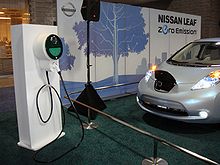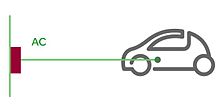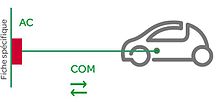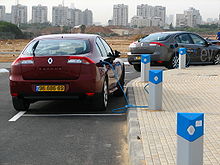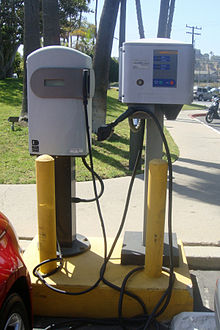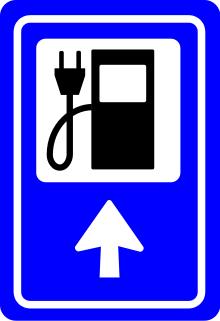- Charging station
-
Level 2 charging station for the Nissan Leaf

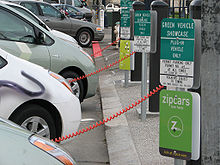 Public charging stations in San Francisco 2009
Public charging stations in San Francisco 2009 This article covers electrical recharging. For pneumatic recharging, see compressed air vehicle.
This article covers electrical recharging. For pneumatic recharging, see compressed air vehicle.
An electric vehicle charging station, also called EV charging station, electric recharging point, charging point and EVSE (Electric Vehicle Supply Equipment), is an element in an infrastructure that supplies electric energy for the recharging of electric vehicles, plug-in hybrid electric-gasoline vehicles) or semi-static and mobile electrical units such as exhibition stands.As hybrid electric vehicles and battery electric vehicle ownership is expanding, there is a growing need for widely distributed publicly accessible power points, some of which support faster charging at higher voltages and currents than are available from domestic supplies. Major installation designs include Park & Charge in Europe and Better Place in America. PARVE is an open-source design being developed in Madrid, Spain. Many charging stations are on-street facilities provided by electric utility companies. Some of these special charging stations provide one or a range of heavy duty or special connectors and/or charging without a physical connection using parking places equipped with inductive charging mats.
Contents
Overview
Safety
Although most rechargeable electric vehicles and equipment can be recharged from a domestic wall socket, a charging station is usually accessible to multiple electric vehicle (EV) owners and has additional current or connection sensing mechanisms to disconnect the power when the EV is not actually charging. This is in case an EV should be carelessly driven away before being unplugged, and so violently rip away the charging cable insulation and expose the electric conductors, which (except for the sensor mechanism) could be dangerous.
There are two main types of safety sensor:
- additional physical 'sensor wires' which provide a feedback signal such as specified by the undermentioned SAE J1772 and IEC 62196 schemes that require special (multi-pin) power plug fittings,
- Current sensors which monitor the power consumed, and only maintain the connection if the demand is within a "window" (for example between 1 ampere and 15 amperes).
Sensor wires react more quickly, have less parts to fail and are possibly less expensive to design and implement. Current sensors however can use standard connectors and can readily provide an option for suppliers to monitor or charge for the electricity actually consumed.
Standards
In SAE terminology, 240 volt AC charging is known as level 2 charging, and 500 volt DC high-current charging is known as DC Fast Charge. Owners can install a level 2 charging station at home, while businesses and local government provide level 2 and DC Fast Charge public charging stations that supply electricity for a fee or free.
The International Electrotechnical Commission (IEC) modes are similar:
- "Mode 1" - slow charging from a regular electrical socket (single or 3-phase)
- "Mode 2" - slow charging from a regular socket but which equipped with some EV specific protection arrangement (e.g. the Park & Charge or the PARVE systems)
- "Mode 3" - slow or fast charging using a specific EV multi-pin socket with control and protection functions (e.g. SAE J1772 and IEC 62196)
- "Mode 4" - fast charging using some special charger technology.
Mode 1: Household socket and extension cord
The vehicle is connected to the power grid through standard socket-outlets (standard current: generally 10 A) present in residences. To use mode 1, the electrical installation must comply with the safety regulations and must have an earthing system, a circuit breaker to protect against overload and a earth leakage protection. The sockets have blanking devices to prevent accidental contacts. This solution is the simplest and the most direct to implement. It offers the driver the option of charging his /her vehicle almost everywhere, which guarantees the peace of mind for the first-time buyers of electric vehicles. Why then can’t we be satisfied with this solution? As a matter of fact, it has several serious limitations and may pose risks if used incorrectly. These limitations have led to the definition of other more efficient charging modes.
The first limitation is the available power, to avoid risks of
- heating of the socket and cables following intensive use for several hours if we exceed the maximum power (which varies from 8 to 16 A depending on the countries in Europe)
- fire or electric injuries in case the electrical installation is obsolete or if certain protective devices are absent.
The second limitation is related to the installation’s power management
- as the charging socket shares a feeder from the switchboard with other sockets (no dedicated circuit) if the sum of consumptions exceeds the protection limit (in general 16A), the circuit-breaker will trip, stopping the charging.
All these factors impose a limit on the power in mode 1, for safety and service quality reasons. This limit is currently being defined, and the value of 10A appears to be the best compromise. It must be noted that at this power, it will take nearly 10 hours to fully charge a vehicle.
No dedicated circuit For instance, in France, the local standard NF-C-15100 standard on installation allows the connection of several household socket-outlets into the same protective element of the dwelling’s electrical switchboard:
- Up to 5 socket-outlets with a cable with a cross-section 1.5 mm2.
Protection by a 16A circuit breaker.
- Up to 8 socket-outlets with a cable with a cross-section 2.5 mm2.
Protection by a 20A circuit breaker.
It is therefore highly probable that the household socket used for charging an electric vehicle is on the same circuit as another electrical appliance, which may also be in operation during the charging.
In this case, the OCP, Overcurrent Protective Device, will open for safety reasons, as the cumulated currents of the electric vehicle and the household appliance will be higher than its setting threshold. Installation of a dedicated circuit for electric vehicle charging can prevent this type of unwanted tripping. Ensuring that any load or appliances on the shared EV charging circuit are turned off while charging, can prevent the OCP from tripping as well. This can be difficult to ensure, so a dedicated circuit is the most reliable solution.
Temperature derating and intensive use We have seen above that fully electric vehicles have charging powers varying from 3 to 24 kW. These powers correspond to charging currents from 16A single-phase up to 32A three-phase. Moreover, charging the vehicle may take up to 8 hours, and this has to be done regularly, even on a daily basis.
The NF-C-15100 standard imposes cable cross-sections of 1.5 mm2 or 2.5 mm2. Their maximum permissible power is 3.7 kW for a 1.5 mm2 cable and up to 5.7 kW for a 2.5 mm2 cable.
Household sockets are designed to be used at full load only for a limited period (typically 1 hour at maximum power, which is the case when we use household appliances). When charging an electric vehicle, the charging time exceeds this limit and can last up to 6 or 8 hours. Household sockets must therefore be classified as derating systems for this use case: their permissible current must be lower than 16A or 32 A in order to limit abnormal temperature increases in components and to prevent fire hazards.
Obsoleteness and non-compliance In France, electrical installation professionals believe that there are about 7 million hazardous electrical installations (obsolete, non-compliant, etc.), accounting for a little less than half of the old residential building stock.
For instance in France, from 1972 onwards, new electrical installations are subject to an inspection and an attestation of compliance. This measure instituted by public authorities was extended in 2001 to the electrical installations of fully renovated dwellings.
However, the electrical installations of the 16 million dwellings built before 1972 are not covered by any regulatory control measure.
There are also misgivings about the condition of electrical installations in the dwellings built after 1972: according to electrical safety experts, an installation in which no change has been made for the last 30 years can be considered as obsolete. They further believe that, after thirty years, even in normal usage conditions, an electrical installation may most likely pose hazards due to wear and tear if no maintenance operation has been carried out since it was set up.
Connecting an electric vehicle without any precaution to this type of installation can therefore be dangerous for people and property when appropriate protective devices are absent.
Mode 2: Domestic socket and cable with a protection device The vehicle is connected to the main power grid via household socket-outlets. Charging is done via a single-phase or three-phase network and installation of an earthing cable. A protection device is built into the cable. This solution is particularly expensive due to the specificity of the cable.
Mode 3: Specific socket on a dedicated circuit The vehicle is connected directly to the electrical network via specific socket and plug and a dedicated circuit. A control and protection function is also installed permanently in the installation. This is the only charging mode that meets the applicable standards regulating electrical installations. It also allows load-shedding so that electrical household appliances can be operated during vehicle charging or on the contrary optimise the electric vehicle charging time.
Mode 4: Direct current (DC) connection for fast recharging The electric vehicle is connected to the main power grid through an external charger. Control and protection functions and the vehicle charging cable are installed permanently in the installation.
Evolution
The coordinated development of charging stations in a region by a company or local government is more fully discussed in the electric vehicle network article. Currently charging stations are being installed by public authorities, commercial enterprises and some major employers in order to stimulate the market for vehicle that use alternative fuels to gasoline & diesel fuels. For this reason most charge stations are currently either provided gratis or accessible to members of certain groups without significant charge (e.g. activated by a free 'membership card' or by a digital 'day code').
Charging time
The arrival of electric vehicles into the everyday life of users should not change their habits, nor should it expose them to new situations that might be potentially hazardous when they charge their vehicles.
The battery capacity of a fully electric vehicle is about 20kWh, providing it with an electrical autonomy of about 150 kilometres; chargeable hybrid vehicles have capacity of roughly 3 to 5kWh, for an electrical autonomy of 20 to 40 kilometres (the heat engine ensures the autonomy of a conventional vehicle).
As this autonomy is still limited, the vehicle has to be charged every 2 or 3 days on average. In practice, the driver will probably charge his / her vehicle as soon as he / she finds an occasion to do so.
For normal charging (3kW), car manufacturers have built a battery charger into the car. A charging cable is used to connect it to the electrical network to supply 230 volt AC current. For quicker charging (22kW, even 43kW and more), manufacturers have chosen two solutions: - use the vehicle's built-in charger, designed to charge from 3 to 43kW at 230V single-phase or 400 V three-phase. - use an external charger, which converts AC current into DC current and charges the vehicle at 50kW.
Charging time Power supply Voltage Max current 6-8 hours Single phase - 3,3kW 230 VAC 16 A 2-3 hours Three phase - 10kW 400 VAC 16 A 3-4 hours Single phase - 7kW 230 VAC 32 A 1-2 hours Three phase - 24kW 400 VAC 32 A 20-30 minutes Three phase - 43kW 400 VAC 63 A 20-30 minutes Continue - 50kW 400 - 500 VDC 100 - 125 A The user finds charging an electric vehicle as simple as connecting a normal electrical appliance; however to ensure that this operation takes place in complete safety, the charging system must perform several safety functions and dialogue with the vehicle during connection and charging.
Infrastructure
Public charging station in a parking lot near Los Angeles International Airport. Shown are two old-style (6kW level2) EVSE units (left: inductive Magne-charge gen2 SPI, right: conductive EVII ICS-200 AVCON.
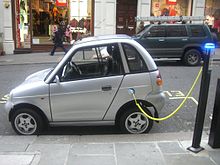 REVAi/G-Wiz i charging from an on-street station in London.
REVAi/G-Wiz i charging from an on-street station in London.
Charging stations for electric vehicles may not need much new infrastructure in developed countries, less than delivering a new alternative fuel over a new network.[1] The stations can leverage the existing ubiquitous electrical grid and home recharging is an option. For example, polls have shown that more than half of homeowners in the USA have access to a plug to charge their cars.[citation needed] Also most driving is local over short distances which reduces the need for charging mid-trip. In the USA, for example, 78% of commutes are less than 40 miles (64 km) round-trip.[2] Nevertheless, longer drives between cities and towns require a network of public charging stations or another method to extend the range of electric vehicles beyond the normal daily commute. One challenge in such infrastructure is the level of demand: an isolated station along a busy highway may see hundreds of customers per hour if every passing electric vehicle has to stop there to complete the trip. In the first half of the 20th century, internal combustion vehicles faced a similar infrastructure problem.
Fast charging
A relatively inexpensive charging station providing 3.3 kilowatts of power (240 volts at 14 amperes) will take several hours to fully recharge an electric vehicle. For example, the Nissan Leaf with its 24 kilowatt-hour battery pack takes approximately 8 hours to recharge.[3]
However, most users will charge every day, so they will very rarely need to fully recharge their battery. So 3.3 kilowatts charging is more than enough for parking at home or work,[4] but not for "refueling" in the middle of a trip.
Subject to the power handling of the car's charging electronics and battery chemistry, higher-power charging stations reduce charging time significantly. The SAE J1772-2009 connector can supply 16.8 kW (240V,70A), the VDE-AR-E 2623-2-2 connector in Europe provides up to 43.5 kW (400V, 63A, three-phase), the J1773 (Magne Charge) inductive paddle can provide 50 kW Nimh batteries to 80% in 12 minutes, CHAdeMO DC Fast Charge (formerly referred to as Level 3) charging stations can supply 62.5 kW (500V DC, 125A); the latter reduces the time to recharge the Nissan Leaf to 80% of capacity to about 30 minutes.[3]
Technical issues
Fast charging requires an industrial-type electric service (i.e., voltage greater than 120 VAC, and maximum current capacity greater than than 15 A; the values found at a typical US residential wall outlet). For example, given a 50 kWh vehicle battery pack and 100% charger efficiency, a 10 minute quick-charge from 10% to 80% battery capacity requires that 210 kW of power be provided to the charger. (80% minus 10% equals 70%. 70% of 50 kWh equals 35 kWh, the amount of energy that the charger must provide to the battery. 10 minutes equals 0.167 hour. 35 kWh divided by 0.167 hour equals 210 kW, the amount of power that the charger must provide during each moment of the charge time.) As a comparison, 210 kW is the total power drawn by approximately 140 US homes (if each home draws 1.5 kW of power, a reasonable value). If the vehicle charger is fed using 480 VAC, 3-phase service, the charger must draw 253 A of current on each phase so that it receives 210 kW of power. In the US, when the electric utility provides 480 VAC, 3-phase service, the most common maximum current capacity provided is 200 A.
A fast charge 'service station' designed to simultaneously fast charge multiple vehicles in the way current gasoline or diesel stations simultaneously refuel multiple vehicles might require a peak power service on the order of several megawatts.
In practice, the energy efficiency of ten-minute charging is likely to be somewhat lowered in any case due to the ohmic losses caused by the required high current inside the vehicle. The lost energy is converted directly to heat, which could be detrimental to the battery pack or surrounding electronics; additional power may be required for cooling equipment that removes the excess heat. Increasing the capacity of the battery pack increases the required power, current and heat loss linearly,[citation needed] which is why ten-minute charging may require new innovations as vehicles with increased range are developed.
The high peak power requirement of ten-minute charging can also stress the local power grid and might increase the risk of power brown- or black-outs during peak demand if enough vehicles choose to charge at these times. Time of use metering can help alleviate this stress by creating economic incentives for vehicles to be recharged at off-peak times. Another solution is to use an energy storage system to bridge the gap between the charging station demand and the power grid. The energy storage system suffers some efficiency drop and thus trades lower overall system efficiency in favor of higher peak demand capacity. Another possibility is on-site, on-demand power generation.[citation needed]
Most charging development focuses on speed of charge using conductive coupling rather than safety,[5] convenience, and ease using inductive charging.[6] Inductive charging had been used on the GM EV-1, Chevy S-10 EV and Toyota RAV4 EV. With current technology, inductive efficiency losses of 8-13% are to be expected.[7] Also, signaling and protective circuitry can address safety concerns associated with conductive coupling.
Mobile stations
Fast charging mobile stations are generally mounted in a vehicle and includes batteries. An example are the Nation-E Angel Cars.[8]
Replacement
One type of battery "replacement" offers a simpler solution. The latest generation of vanadium redox battery has an energy density similar to lead-acid batteries; however, the charge is stored solely in a vanadium-based liquid electrolyte which can be pumped out and replaced with charged fluid. The vanadium battery system is also a potential candidate for intermediate energy storage in ten-minute charging stations because of its high power density and extremely good endurance in daily use. System cost however, is still prohibitive. As vanadium battery systems are estimated to cost between $350–$600 per kW·h, a battery that can service one hundred customers in a 24 hour period at 50 kW·h per charge could cost $1.8-$3 million.[9]
Faster charging
JFE Engineering Corporation is developing a quick charge system that it claims can take a battery from zero charge to 50% full in about 3 minutes. It has two batteries, one that stores electrical energy from the grid and another that delivers it to the car at extremely high current (500-600 amps, 20kW), which allows it to use a low-voltage power supply (AC200V; while the existing rapid charging systems require a higher power supply voltage 50 kW or more, AC6.6kV).[10] The company claims that even though one station costs about $63,000, that’s roughly 40% less than the competing CHAdeMO system.[11]
AeroVironment's Fleet Fast Charging Station aims to making "filling up" at the EV30-FS similar to using a gas pump. According to AV's website, "As battery chemistries evolve to support faster charging, a 25kWh EV battery may eventually receive up to an 80% battery capacity charge in less than 10 minutes, depending on conditions."
Smart grid communication
Recharging a large battery pack presents a high load on the electrical grid, but this can be scheduled for periods of reduced load or reduced electricity costs. In order to schedule the recharging, either the charging station or the vehicle can communicate with the smart grid. Some plug-in vehicles allow the vehicle operator to control recharging through a web interface or smartphone app.[citation needed] Furthermore, in a Vehicle-to-grid scenario the vehicle battery can supply energy to the grid at periods of peak demand. This requires additional communication between the grid, charging station, and vehicle electronics. SAE International is developing a range of standards for energy transfer to and from the grid including SAE J2847/1 "Communication between Plug-in Vehicles and the Utility Grid".[12]
Deployment of public charging stations
Locations
Charging stations can be found and will be needed where there is on-street parking, at taxi stands, in parking lots (at places of employment, hotels, airports, shopping centers, convenience shops, fast food restaurants, coffeehouses etc.), phone booths, as well as in driveways and garages at home. Existing filling stations may also become or may incorporate charging stations. They can be added onto other public infrastructure that has an electrical supply, such as phone booths[13] and smart parking meters.
Anxiety regarding range and finding charging stations can be a major concern for EV drivers; this can be helped with online directories such as EV-Networks[14] or some charging station providers like POD Point in the UK publish live availability[15] of their charging locations for EV drivers.
In the UK most charging points have highly visibly indicator lights[16] on the charging point to show whether it is available, charging or out of service.
Vehicle and charging station projects and joint ventures
Main article: Electric vehicle networkElectric car manufacturers, charging infrastructure providers, and regional governments have entered into many agreements and ventures to promote and provide electric vehicle networks of public charging stations.
The EV Plug Alliance[17] is an association of 21 European manufacturers which proposes a safe connecting solution. The project is to impose an IEC norm and to adopt a European standard for the connection solution with sockets and plugs for electric vehicle charging infrastructure.
The EV Plug Alliance has the highest safety level thanks to the adoption of protective shutters to prevent any accidental contact with live parts and the expertise of its members: Schneider Electric, Legrand, Scame, Nexans, etc.
EV charging station signs
In the United States, the standard charging station sign is defined in the Federal Highway Administration's Manual on Unifrom Traffic Control Devices (MUTCD) 2009 edition. There is an open source, public domain European charge station sign proposed.[18]
Block heater power supplies
In colder areas such as Finland, some northern US states and Canada there already exists some infrastructure for public power outlets provided primarily for use by block heaters and set with circuit breakers that prevent large current draws for other uses. These can sometimes be used to recharge electric vehicles, albeit slowly, when the temperature falls below -20°C.[19]
Battery swapping
A charging station is different from a battery switch station, which is a place to swap a discharged battery or battery pack for a fully charged one, saving the delay of waiting for the vehicle's battery to charge. Battery swapping is common in warehouses using electric forklift trucks.[20] The companies Better Place, Tesla Motors, Mitsubishi Heavy Industries[21] and others are currently working in integrating battery switch technology in their electric vehicles to extend their driving range. Better Place is using the same technology to swap batteries that F-16 jet fighter aircraft use to load their bombs.[22]
In a battery switch station, the driver does not need to get out of the car while the battery is swapped.[23] Better Place's automated battery-switching station (also called Quickdrop Stations) can complete a battery swap in less than one minute,[24] which is faster than refueling a conventional petrol car.
SwapPack, a Texas entity, is developing as of April 2010 a swap arrangement, similar to the swapping out of butane gas tanks at convenience stores, a similar swap at car dealerships and large wholesale big box retailers. These locations will allow drivers the security of making a quick change of battery packs to have a power pack that is totally recharged. As of November 2010 the batteries of existing hybrid/electric cars, i.e. Prius, have not yet expired after a 100,000-mile (160,000 km) duration.
Battery swap depends on at least one electric car designed for "easy swap" of batteries. However, electric vehicle manufacturers that are working on battery switch technology have not standardized on battery access, attachment, dimension, location, or type. Better Place announced the Renault Fluence Z.E. would be the first electric car with a switchable battery available on the Better Place network,[25] also Tesla Motors are integrating one minute battery switch technology[26] in their Model S sedan with the possibility to rent 300-mile (480 km) batteries for longer trips.[27]
Summary of benefits of battery swapping:
- Fast battery swapping of around 59.1 seconds.[24]
- Unlimited driving range where there are battery switch stations available.[28]
- The driver does not have to get out of the car while the battery is swapped.[29]
- The driver does not own the battery in the car, transferring costs over the battery, battery life, maintenance, capital cost, quality, technology, and warranty to the battery switch station company.[30]
- Contract with battery switch company could subsidize the electric vehicle at a price lower than equivalent petrol cars.[31]
- The spare batteries at swap stations could participate in vehicle to grid storage.[citation needed]
Incidents
In 2011 a Zotye Langyue EV taxicab in Hangzhou, China caught fire and was destroyed, although the driver and passenger were able to escape unharmed. Later investigation by the city's Quality Supervision and Inspection Administration revealed that the fire had been caused by an issue with taxi's defective swappable battery pack. Although the batteries themselves were not designed for automotive use, the battery pack had been poorly taken care of which caused damage to the insulation between the battery cells and the aluminum casing, creating numerous short circuits. It was one of the stronger short circuits which ignited the car. The remaining 29 taxicabs belonging to the city (14 produced by Zotye International and 15 produced by Haima) were withdrawn from service that day and modified before going back into service.[32]
Renewable electricity and RE charging stations
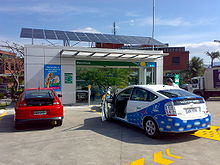 A modified Toyota Prius and Honda Insight at a charging station in Rio De Janeiro. This station is run by Petrobras and uses solar energy.
A modified Toyota Prius and Honda Insight at a charging station in Rio De Janeiro. This station is run by Petrobras and uses solar energy. See also: Solar-charged vehicle
See also: Solar-charged vehicleCharging stations are usually connected to the electrical grid, which often means that their electricity originates from fossil fuel plants or nuclear power plants. Solar power is also suitable for electric vehicles. SolarCity is marketing its solar energy systems along with electric car charging installations. The company has announced a partnership with Rabobank to make electric car charging available for free to owners of Tesla Motors' vehicles traveling on Highway 101 between San Francisco and Los Angeles. Other cars that can make use of same charging technology are welcome.[35]
E-Move Charging Station
The E-Move Charging Station is equipped with eight monocrystalline solar panels, which can supply 1.76KWp of solar power. With further refinements, the designers are hoping to generate about 2000KWh of electricity from the panels over the year.[36]
See also
- Automated charging machine
- Battery charger
- Battery leasing
- Coulomb Technologies
- Circontrol
- Direct coupling
- Dump charging
- Electric vehicle battery
- Electric vehicle network
- Elektromotive
- EV Project
- Filling station
- IAV
- In-road electric vehicle charger
- Lamppost
- Magne Charge
- Park & Charge
- PARVE Charging System
- Plugless Power
- Pod Point
- RFID
- SAE J1772 and CHAdeMO charging standards
- SemaConnect
- Solar-charged vehicle
- Transport electrification
- V2G, V2Green and V2H
Notes
- ^ "Plug-In 2008: Company News: GM/V2Green/Coulomb/Google/HEVT/PlugInSupply". CalCars. 2008-07-28. http://www.calcars.org/calcars-news/976.html. Retrieved 2010-05-30.
- ^ Source: US Department of Transportation, Bureau of Transportation Statistics, Omnibus Household Survey. Data from the February, April, June, and August 2003 surveys have been combined. Data cover activities for the month prior to the survey. (October 2003). "From Home to Work, the Average Commute is 26.4 Minutes". OmniStats 3 (4). http://www.bts.gov/publications/omnistats/volume_03_issue_04/pdf/entire.pdf#page=4. Retrieved 2009-10-15.
- ^ a b "Nissan LEAF Electric Car | Answers | Charging". Nissan. http://www.nissanusa.com/leaf-electric-car/faq/list/charging#/leaf-electric-car/faq/list/charging. Retrieved 2010-05-25.
- ^ Takafumi Anegawa (2009-10-13). "Desirable characteristics of public quick charger". Tokyo Electric Power Company. p. 33. http://www.emc-mec.ca/phev/Presentations_en/S12/PHEV09-S12-3_TakafumiAnegawa.pdf. Retrieved 2010-06-27.
- ^ Dallas Kachan (January 20, 2010). "'Disaster' scenarios for electric cars". Cleantech Group. http://cleantech.com/news/5537/electric-vehicle-car-disaster-market. Retrieved 2010-03-09.
- ^ Stephen Marcus (February 15, 2010). "Contenders vie for quickest EV battery charging time". Cleantech Group. http://cleantech.com/news/5628/quickest-ev-battery-recharge-fast. Retrieved 2010-03-09.
- ^ "Staff Paper on the Standardization of Electric Vehicle Charging Infrastructure". California Air Resources Board. 2001-02-26. Archived from the original on 2003-05-09. http://web.archive.org/web/20030509053004/http://www.arb.ca.gov/msprog/zevprog/charging/staffpaper.pdf. Retrieved 2009-10-15.
- ^ http://nation-e.com/
- ^ The Energy Blog: Vanadium Redox Flow Batteries
- ^ Keisuke Ogawa (2010-06-21). "JFE Engineering Announces 'Super-rapid' EV Charging System". Tech-On!. Nikkei Business Publications. http://techon.nikkeibp.co.jp/english/NEWS_EN/20100621/183598/. Retrieved 2010-06-27.
- ^ Nick Chambers (2010-05-05). "Ultra Quick Battery Charge System Developed: 50% Full in 3 Minutes". gas2.0. http://gas2.org/2010/05/05/ultra-quick-battery-charge-system-developed-50-full-in-3-minutes/#more-7511. Retrieved 2010-06-27.
- ^ "SAE Ground Vehicle Standards Status of work – PHEV +". SAE International. 2010-01. pp. 1–7. http://www.sae.org/smartgrid/sae-standards-activities-phev.pdf. Retrieved 2010-09-03.
- ^ "ENDESA AND TELEFÓNICA LAUNCH FIRST ELECTRIC VEHICLE TELEPHONE BOOTH RECHARGING STATION." (Press release). Endesa. 2010-05-10. http://www.endesa.es/Portal/en/press/press_releases/our_companies/endesa/2010/120510CabinasRecharging.htm. Retrieved 2010-05-21.
- ^ http://www.ev-network.org.uk/Default.aspx?pageId=524100
- ^ http://www.pod-point.com/live-availabilty/
- ^ http://www.pod-point.com/using-pod-point/
- ^ http://www.evplugalliance.org/
- ^ http://evinfra.org
- ^ Park and Ride Locations, Calgary Transit, 16 April 2009, http://www.calgarytransit.com/html/park_n_ride_locations.html, retrieved 2009-04-25, "The plug-ins located in the Park and Ride lots automatically turn on when the outside temperature falls below -20 degrees and turn off and on in increments to save electricity usage."
- ^ "Industrial electrical vehicle stalwarts head out on the road". http://us.simplenewz.com/industrial-electrical-vehicle-stalwarts-head-out-on-the-road--2009-03-08--ars-technica--30.672.7.
- ^ "Mitsubishi working on battery swapping for transit buses, Better Place not involved". http://green.autoblog.com/2010/04/29/report-mitsubishi-working-on-battery-swapping-for-transit-buses/.
- ^ "Charging Ahead With a New Electric Car". http://www.smithsonianmag.com/specialsections/40th-anniversary/Charging-Ahead-With-a-New-Electric-Car.html.
- ^ "Better Place. Battery switch stations". http://www.betterplace.com/the-solution-switch-stations.
- ^ a b "Better Place expands Tokyo battery swap trials; taxis have changed packs 2,122 times already". http://green.autoblog.com/2010/08/27/better-place-expands-tokyo-battery-swap-trials-taxis-have-chang/.
- ^ "Better Place. The Renault Fluence ZE". Better Place. 2010-10-22. http://www.betterplace.com/the-company-multimedia-photos/index/id/72157623854339020. Retrieved 2010-10-22.
- ^ "Tesla Model S specs". http://www.teslamotors.com/models/specs.
- ^ "Tesla Model S customers will be able to swap batteries at Tesla dealerships with the possibility to rent 300 mile batteries for longer trips.". http://www.autoweek.com/article/20090327/CARNEWS/903279971.
- ^ "Better Place, California Battery Switch Station Deployment". http://www.betterplace.com/uploads/ckfinder/images/CaliforniaDeployment290x301.png.
- ^ "Better Place, battery switch station description". http://www.betterplace.com/the-solution-switch-stations.
- ^ "Lithium Ion Israel". http://metrikminute.com/lithium-ion-israel/.
- ^ "Better Place's Renault Fluence EV to sell for under $20,000". http://green.autoblog.com/2009/12/21/better-places-renault-fluence-ev-to-sell-for-under-20-000/.
- ^ "Battery Pack Defects Blamed for Zotye EV Fire". ChinaAutoWeb. http://chinaautoweb.com/2011/06/battery-pack-defects-blamed-for-zotye-ev-fire/. Retrieved 6 July 2011.
- ^ "PNNL Solar Array Photos". Hire Electric Blog. Hire Electric, Inc.. http://hireelectric.com/2010/pnnl-solar-array-photos/. Retrieved 16 March 2011.
- ^ "PNNL puts finishing touches on it's first solar panel project". KNDO News. KNDO. http://www.kndo.com/Global/story.asp?S=13615418. Retrieved 16 March 2011.
- ^ http://www.greentechmedia.com/articles/read/solarcity-installs-electric-car-chargers-along-cal-highway/
- ^ http://www.ecofriend.org/entry/eco-tech-e-move-charging-station-fuels-just-about-everything-with-solar-energy/
External links
- Alternative Fueling Station Locator (EERE): US charging stations.
- Electromaps - Recharge points for electric vehicles Find where recharge your electric vehicle
- EV Charger News - website/mailing list
- UK directory of charge points / charging stations.
- Recargo - community-driven directory of charging stations
- Schneider Electric charging solutions EVlink charging solutions for electric vehicles
- Plug-In Charging Stations List of US Charging station networks and phone numbers
- www.gidophone.com Mobile device charging kiosk
Categories:- Charging stations
- Renewable electricity
Wikimedia Foundation. 2010.

